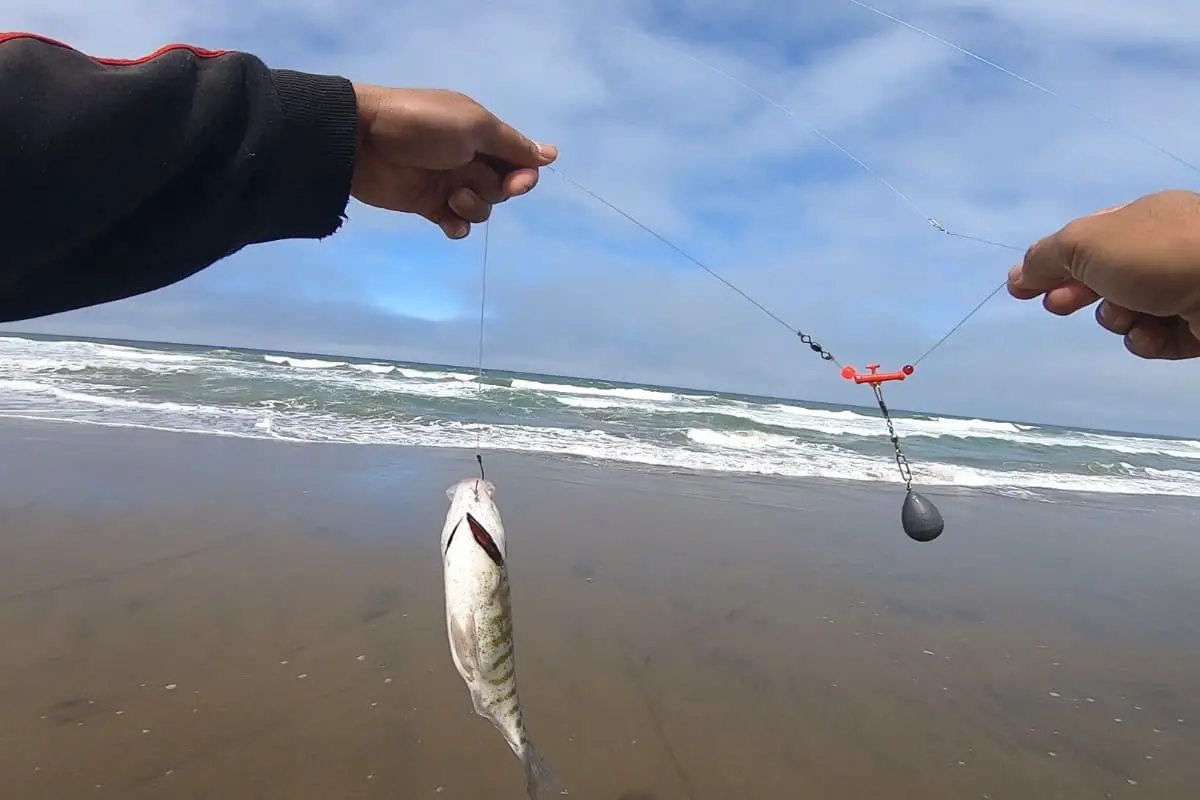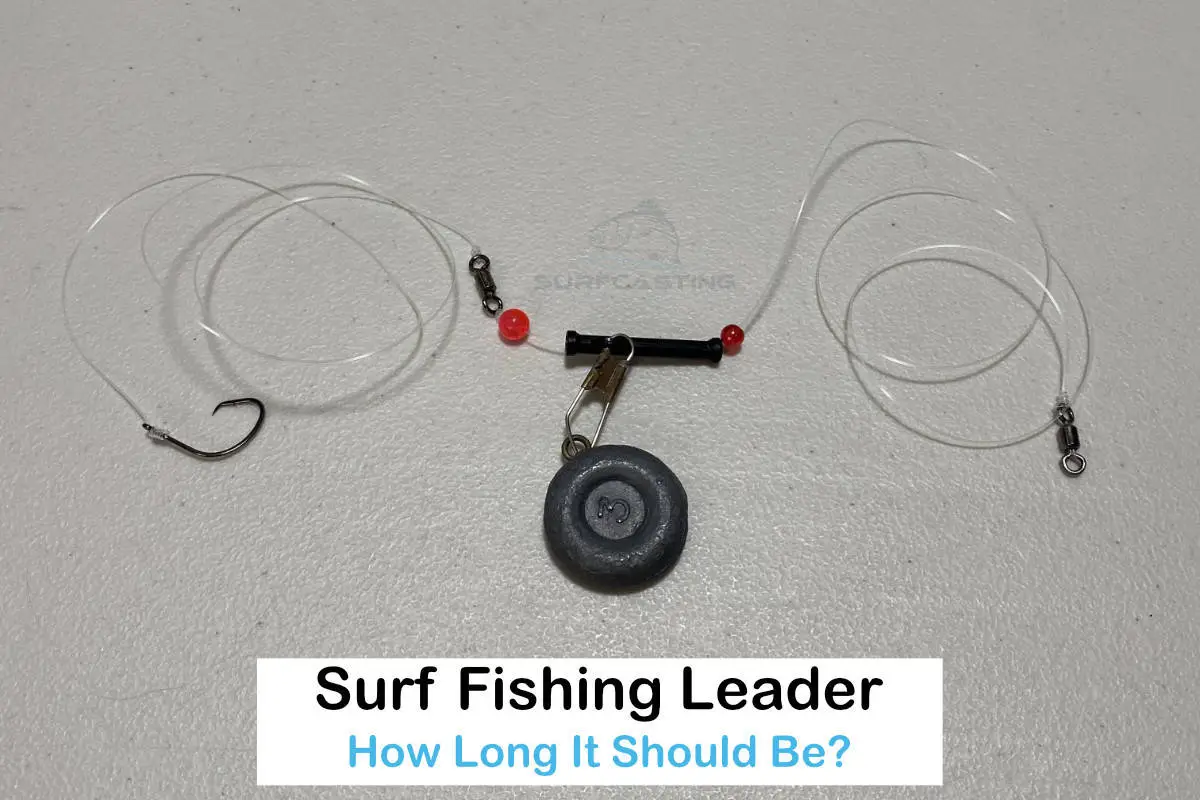Any surf caster looking to leave fish in the sea just needs to use the wrong length of leader. With the right rig and leader, surf casters can catch bluefish, redfish, black drum, tautog, flounder, bonito, tuna, mackerel, tarpon, striped bass, surfperch, and sharks.
Leaders are an underappreciated but essential part of an angler’s kit. How long should a surf fishing leader be?
There’s a lot to consider when deciding the length of a surf fishing leader. The most important factors are what species you’re trying to catch, and what type of rig you’re going to use. As a rule of thumb, use a leader from 12″ to 30″ long. To choose within that range, take water, seabed, and surf conditions into account.
There are many aspects and choices to consider when choosing the ideal length of a surf fishing leader . Let’s go through the factors and elements.
. Let’s go through the factors and elements.
How To Determine The Length Of A Surf Fishing Leader?
At least six factors determine the best length of a surf fishing leader: current, seabed, species, visibility, depth of surf, and rig.
You want your leader to be as stable as possible in the surf, so you can control where your bait will land and go. So, when fishing in strong currents, err on the side of a short leader.
Your baited hook will be more stable, and your bait will stay in the preferred strike zone longer. If you’re fishing in an area with sandy and clear seabed’s, the risk of using a longer leader is low.
There’s nothing for it to get snagged on. In crowded and rough seabed’s, use shorter leaders.
If you’re targeting sharp-toothed species — sharks or bluefish — you’ll want a thicker and stronger leader line than otherwise. You’ll also want a longer than usual leader line so those fish can’t reach your mainline.
Your leader should be longer than the average length of the species you’re fishing. Otherwise, a thrashing fish may get tangled up in your leader and mainline.
When in the clearest waters, use longer leader lines than you would in cloudy conditions. You can get away with shorter leaders in murky water conditions because your terminal tackle is simply less visible to your target fish.
The bait placement sweet spot is a few inches above the sea bottom so that fish will be encouraged to strike, but not so shallow that the fish hesitate to come up to strike.
The deeper the surf, the longer your leader will need to be. Consider having several leader lines set up in advance so you can take advantage of different conditions without having to start from scratch at the moment.
Different kinds of rigs and their leader length
Surfcasting anglers use a wide variety of gear set-ups depending on their personal preferences and style, the types of fish they’re chasing, and the water conditions they’re working in.
The ideal leader length varies according to the factors discussed above and from one type of rig to the next.
Here are eight different types of surfcasting rigs and what you need to know about choosing a leader length for each of them.
Fish finder Rig
With just a leader and hook attached to your mainline with a barrel swivel, the fish-finder rig is the simplest one on the water.
When fishing for fluke, use a 30″ leader so the bait can flutter a bit in the water.
If fishing for stripers, your lead could be 6″ if you have to cast a long way. Closer to shore, a 24″ or 30″ leader is ideal.
Carolina Rig
If surf perch are your target, consider using a Carolina Rig. When using a Carolina Rig using bait such as sandworms, use a 24″ leader between your baited hook and your mainline.
Attach a bullet weight at the end of your mainline, just above your swivel.
High-Low Rig
In a High-Low Rig, two or more hooks are placed above each other on your leader. When using a High-Low Rig for smaller fish, use a piece of monofilament line the length of your arm.
Tie four dropper loops — each 3″ to 4″ apart. At the end of the bottom loop, place a sinker. Tie a hook to the end of the two middle loops and attach your main line to the top loop.
If fishing for larger fish, use a 6″ to 8″ length of leader between snap swivels and three-way swivels. At the end of each leader, attach a hook using a Snell knot.
When setting your leader length, keep them short enough that your hooks don’t get tangled up.
Flapper Rig
Flapper Rigs come in one-, two-, or three- hook models and are considered one of the simplest of surf fishing rigs. Commonly, hook traces are tied to a swivel, and the swivel is placed on the body line between beads and locking crimps.
Assuming you’re using a three-hook Flapper Rig, your leader should be roughly 180 cm long, with 45 cm between the lead line and your first hook trace, and 45 cm between your last hook trace and the weight.
Clipped Rigs
Although it is made up of more components than the less complex Flapper Rig, Clipped Rigs are preferable when you need to cast farther into the surf or when fishing over sandy beaches.
The leader in a Clipped Rig should be approximately 36″. Each snood, running from leader to hook, should be 24″ long.
Loop Rigs
If maximizing casting range and using triple hooks is your priority, consider using a Loop Rig. Building the rig on a 24″ leader will allow longer casts than the same three hooks placed along with a 48″ leader.
Shorter leaders encounter less resistance while flying through the air. As a rig designed specifically for the longest possible casting, keep the strength of your mainline in mind. Use at least a 60 lb. mainline.
Pulley Rig
Surf casters use pulley Rigs on the hunt for sharks. A standard Pulley Rig set up consists of the following components: sinker, bait clip, running line, swivel, leader, and hook. Leaders on a Pulley Rig for fishing for sharks are roughly 36″ long.
Striped Bass Plugging
When striped bass plugging, opt for a six-foot-long rod and reel capable of 20 to 30 lb fused line. Attach your main line to a 36″ leader made from 30 to 50 lb. fluorocarbon. The connection between the mainline and leader is made using a 50 lb. barrel swivel.
Related Post: How To Catch Striped Bass From The Surf?
What is a fishing leader, and why do I need one for surf fishing?

A fishing is a short length of strong line — usually stronger and less visible than your main line — that runs between your hook/bait combination and the mainline that is in your reel.
The goal is to prevent your target fish from biting off your mainline. You don’t want your fish to bite off any line, of course.
But if any line is going to be bitten off or rubbed through by your fish while it strikes at your baited hook or fights against you, you’d like it to be your short leader and not your main line.
Your leader line  is also likely to be thicker and heavier than your mainline. After all, much as you’re hedging against that leader getting broke, you’re still taking precautions against that.
is also likely to be thicker and heavier than your mainline. After all, much as you’re hedging against that leader getting broke, you’re still taking precautions against that.
By using leader lines, though, you won’t need to have your whole reel filled with that thicker and heavier line. If you did, your casting distances would shrink dramatically while the weight of your kit would rise in a hurry.
though, you won’t need to have your whole reel filled with that thicker and heavier line. If you did, your casting distances would shrink dramatically while the weight of your kit would rise in a hurry.
What material is best for a leader?
Choosing the best material for surfcasting is a matter of balancing strength and durability against weight and visibility, depending on those facts we talked about above. There are three main types of leader lines, each with their pros and cons.
Monofilament
On the plus side, a monofilament leader line is less expensive than other options. It’s also stretchable and at least somewhat abrasion-resistant. On the downside, the monofilament leader line gets weaker over time because it absorbs sunlight and water.
is less expensive than other options. It’s also stretchable and at least somewhat abrasion-resistant. On the downside, the monofilament leader line gets weaker over time because it absorbs sunlight and water.
Fluorocarbon
On the plus side, fluorocarbon leader lines do not, unlike monofilament lines, absorb sunlight and water. As a result, they generally last longer, especially when you factor in greater resistance to abrasion. Throw in their near invisibility, and you’ve got a terrific option. The downside? Price.
do not, unlike monofilament lines, absorb sunlight and water. As a result, they generally last longer, especially when you factor in greater resistance to abrasion. Throw in their near invisibility, and you’ve got a terrific option. The downside? Price.
Steel
Fishing for sharp-toothed sharks or bluefish? Consider a steel leader line for its strength alone. On the other hand, its increased strength is coupled with greater weight and higher visibility.
for its strength alone. On the other hand, its increased strength is coupled with greater weight and higher visibility.
Steel leader lines are a good option where strength is the biggest need, but not a good option where you’re seeking to prioritize low weight and low visibility.
Summary
Choosing the right leader length for surfcasting depends on a lot of factors and details, especially the type of rig that you’ll be using, the type of fish you’re looking to catch, and the water and sea bottom conditions you’ll be fishing in.
depends on a lot of factors and details, especially the type of rig that you’ll be using, the type of fish you’re looking to catch, and the water and sea bottom conditions you’ll be fishing in.
Take every one of those factors into account when cutting your leaders. A leader that is too long or short won’t reach or will outreach your next fish, no matter how good your bait and cast.


